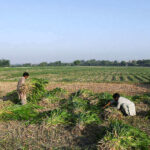Is pressure on the way?
The sugar futures market in NY closed out Friday with May/2022 at 18.93 cents per pound, a 30-point drop – equivalent to 6.60 dollars per ton – over the week. The following maturities, at least up until October/2023, closed between 1 and 9 dollars down per ton as well. The trading volume over the week was below normal maybe because most traders were at the Sugar Annual Conference, which took place in Dubai.
The real appreciated against the dollar this week, which caused a drop in sugar prices converted into real per ton, even after the Brazilian Central Bank raised the basic interest rates of the economy to 11.75% per year, which increased the quotation of the real over time. The net present value (NPV) of the prices related to the 2022/2023 crop closed out at R$2,153 per FOB Santos ton, a little under the value of those fixed by the mills (R$2,178) for the crop starting now. The NPV of the average closing quotations related to the 2023/2024 crop was R$1,960 per ton.
Oil dropped by about 5% over the week, but Petrobras price difference against the world market was at 11% lower at Friday’s closing, so we don’t believe the company will reduce the price at the refinery.
The funds have strongly liquidated their long position, selling – according to CFTC (Commodity Futures Trading Company), 52,000 contracts over the week (from Tuesday to Tuesday). Is that a sign of a shift?
We still keep a neutral to bearish view for the 2022/2023 crop, strongly believing that the market should go to cash and carry due to the well-balanced world sugar supply and demand, high interest rates that curb stock building, high inflation rate and family income loss.
Cash and carry mean the shortest maturities should depreciate faster than the longest ones. The funds massive selling can be a sign that they could be shifting (changing from long to short). What can change this picture is the size of the sugarcane crop in the Center-South. Some mills believe the production shouldn’t reach the average of 554 million tons of sugarcane that the market seems to be considering. Should this happen, the market has less room to fall.
For the 2023/2024 crop, the scenario can be pretty different. It will depend on how the market is supplied with fertilizers and other chemicals and at what price. A substantial increase in the production cost – estimated at R$1,580 per FOB Santos ton today – can wipe out any margin (see mentioned above that today’s closing of the 2023/2024 crop would settle R$1,960).
It’s also unclear whether corn on a high trend can hurt the economic feasibility of the corn ethanol internally in addition to the almost non-existent expansion of the sugarcane area. That’s why we have a neutral to bullish outlook for the 2023/2024 crop, not recommending the selling hedge right now, but if absolutely necessary, it should at least come together with a purchase of a call 200 points above the hedged value in cents per pound.
The recent pressures on the commodities market, especially on nickel, oil and wheat, were a wakeup call to the banks that fund the trading companies. Obviously, when a stressful situation comes up on the futures markets, the needs imposed by initial margin calls and daily adjustments blow up and dry up the availability of resources that the trading companies have in cash flow for their overriding activity, which is to sell commodities.
The concern over seeing the company’s cash flow shrinking is psychologically devastating. Who doesn’t remember the cash flow stress the sector went through in the 2010/2011 crop when, in May/2010 right at the Sugar Dinner in NY, the market hit 13 cents per pound (equivalent to R$1,290 today), in the midst of the belching of wisdom of bears who were pointing to a famous and unquestionable drop towards 10 cents? Only 9 months later, sugar was trading at 36.08 cents per pound in NY (equivalent to R$3,080 per ton today), an increase of 178%! It takes a lot of level-headedness and cash flow surplus to deal with all this.
The century-old LME (London Metal Exchange) closed nickel negotiations two weeks ago and canceled several operations with the metal whose value was over some billions of dollars. The argument of the exchange is that if it hadn’t done that, several brokers would have closed down. For the financial institutions, however, the fact draws attention to the danger that can come out of stressful situations and systemic risk that can act as a ripple effect.
The tension on the nickel market was caused by a great Chinese trader who was short way beyond his limit. The fact LME has belonged to China since 2012 is just a detail (yeah, right). Just like in 2008 with the Lehman Brothers’ episode, it wouldn’t be surprising if the regulators started paying more attention to the commodities markets that can affect the food chain (grains and softs, for example).
When a commodity price goes up, the trading companies need more working capital so they can keep the same trading volume. It’s important to point out that the agricultural trading companies aren’t going through any dramatic situation, but it’s undeniable that when a yellow light goes on after risk situations in other commodities, it’s just natural for financial institutions around the world to get more alert.
To read the previous episodes of World Sugar Market – Weekly Comment, click here
To get in touch with Mr. Arnaldo, write on arnaldo@archerconsulting.com.br
















